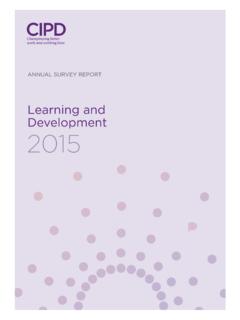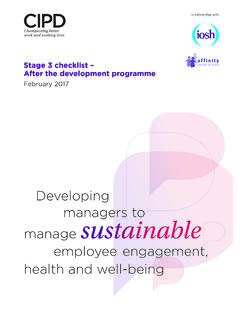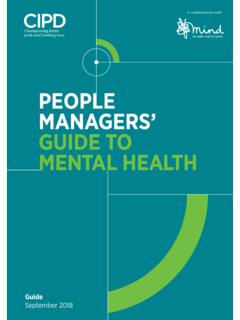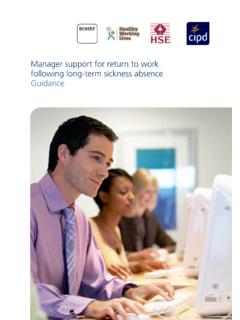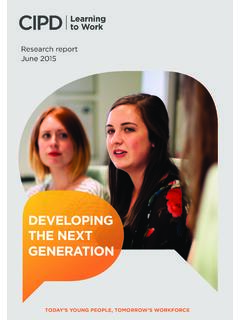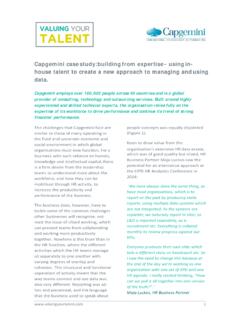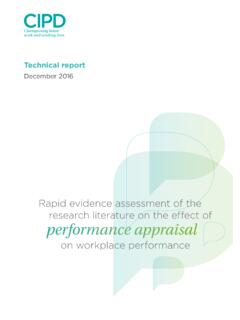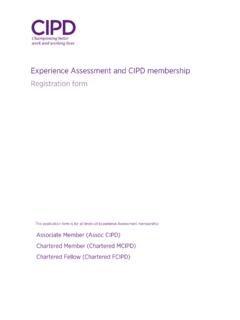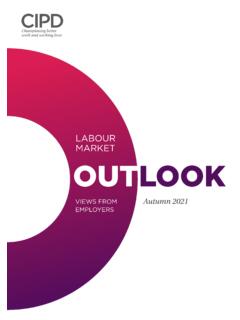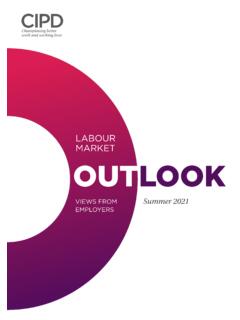Transcription of A guide for people professionals THE MENOPAUSE AT WORK
1 March 2019. A guide for people professionals THE. MENOPAUSE . AT work . The CIPD is the professional body for HR and people development. The not-for-profit organisation champions better work and working lives and has been setting the benchmark for excellence in people and organisation development for more than 100 years. It has 150,000. members across the world, provides thought leadership through independent research on the world of work , and offers professional training and accreditation for those working in HR and learning and development. The MENOPAUSE at work : a guide for people professionals guide 1. The MENOPAUSE at work : a guide 2 for people professionals 3. 4. Contents 5. 1 Introduction: purpose of this guide 2. 6 2 What is the MENOPAUSE ? 6. 3 Create an open, inclusive and supportive culture 12. 7. 4 Develop a framework to manage the MENOPAUSE 15. 8 5 Manage health and sickness absence 19. 6 Promote good people management 24. 9. 7 Useful resources 27. 10 8 References 27.
2 9 Endnotes 28. 10 Appendix 1 University of Leicester MENOPAUSE Policy 29. Appendix 2 West Midlands Police: Reasonable Adjustments Passport Appendix 3 The University of Manchester manager Guidance: MENOPAUSE in the Workplace 1. The MENOPAUSE at work : a guide for people professionals Acknowledgements 1 The CIPD is incredibly grateful to the organisations and CIPD members who gave their time and expertise to provide feedback to help inform this guide . These include: the members of the CIPD Birmingham branch; Deborah Garlick, Director of Henpicked: MENOPAUSE in the 2 Workplace; Lynda Bailey, Co-founder and Director of Talking MENOPAUSE ; the Civil Service Employee Policy team and the cross-Civil Service MENOPAUSE Working Group; Jog Hundle, 3 Partner, Mills & Reeve LLP; Professor Carol Atkinson, Associate Dean: Research Manchester Metropolitan University Faculty of Business and Law; Clare Knox, Founder and Business Psychologist, See Her Thrive. Thank you also to: Dr Andrea Davies, Senior Research Ethics 4 Officer and Associate Professor in Marketing and Consumption, and Nicola Junkin, Staff Health and Wellbeing, Recruitment Strategic Lead, the University of Leicester; and Gemma Dale, Policy manager , the University of Manchester, for use of their policies and guidance.
3 5. We would also like to thank those individuals and organisations that enabled us to include case studies in the guide : Bernice Allport of the Environment Agency; Janet Trowse and 6 Karen Venn of Network Rail; Kirstie Williams, Civil Service HR team; Catherine' of West Midlands Police; Juliet Saimbi of Severn Trent; and Alison McBirnie, Myra Gilbert and Leah Lee of the Solicitors Regulation Authority. 7. All of the people we spoke to in developing this guide were inspiring as well as knowledgeable, and made the process a truly collaborative one. We are glad to be able to showcase their 8 efforts to break down the stigma around the MENOPAUSE and create more inclusive workplaces. Their experiences bring this guide to life and reflect their passion and hard work . 9. Why this matters 10 work can and should be a force for good. It should benefit workers, the organisations they work for, and the communities and societies they live in. This starts with valuing people both their contribution to business success and their fundamental right to lead a fulfilling and healthy working life.
4 1 Introduction: purpose of this guide Key points people experiencing menopausal symptoms require the same support and understanding from their employer as anyone experiencing any ongoing health condition. Employers need to break the stigma and taboo surrounding the MENOPAUSE at work and create an inclusive working environment where employees and managers feel confident to discuss any practical adjustments that may be needed. 2 Introduction: purpose of this guide The MENOPAUSE at work : a guide for people professionals The MENOPAUSE is a natural stage of life experienced by most women and yet it remains a taboo subject in many workplaces. While some menopausal women receive help 1 and understanding from colleagues and managers, research shows that many do not disclose their symptoms to management (Griffiths et al 2010). Many employees are too embarrassed to discuss the issue or think their manager would be embarrassed. The 2 result is that most women typically suffer in silence', while often a few small practical adjustments at work could make a world of difference to someone experiencing some of 3 the uncomfortable symptoms of the MENOPAUSE .
5 The research also shows that nearly one in five women thought that the MENOPAUSE had a negative impact on their managers' and colleagues' perceptions of their competence at work . 4 This reluctance to discuss the MENOPAUSE is understandable, but there should be no need for women to feel isolated and scared to seek the support that could transform their 5 working life. The MENOPAUSE transition need not be an awkward topic and it shouldn't be regarded solely as a female issue. 6 All employers should consider making provision and ensuring support for older women who are going through the MENOPAUSE 7 too many older women are left to cope on their own, without support or understanding from colleagues or managers.'. 8 Dr Ros Altmann CBE, 2015. Employers should support people with menopausal symptoms in the same way as they 9 would with any other health condition. Organisations have a responsibility to create a stigma-free environment that encourages open discussion and disclosure; this will encourage women to not suffer in silence and discuss the practical steps needed to 10 support their full engagement and productivity at work .
6 We need to normalise the conversation about the MENOPAUSE in the same way many workplaces have begun to break down the barriers and foster inclusion around mental health issues. There is a compelling rationale for taking this issue seriously, starting with the number of working women whose working lives could be positively affected by creating MENOPAUSE -friendly workplaces. The average age of the MENOPAUSE is 51. For years there has been a steady increase in the employment rate of women over 50 in the UK, and this trend is likely to continue given the ageing population. There are now around million women aged 50 64 in work (ONS. 2019), and the vast majority of these will go through the MENOPAUSE transition during their working lives. Therefore, the potential to support the continued employment of women in the perimenopausal and menopausal age bracket, for the benefit of themselves and organisations as well as the wider economy, is considerable. At the same time, the quality of working life for women experiencing the MENOPAUSE could be improved for millions now and in the future.
7 Who is the guide for? We know employers come in all shapes and sizes, with different working practices and environments. This guide is designed to support any employer wanting to develop a supportive framework for employees experiencing the MENOPAUSE . We hope it will be a useful professional resource for HR and occupational health teams in particular. Please note that we are not providing legal or medical advice, but practical guidance employers may also need to obtain their own specialist advice on the approach to take in any individual case. 3 Introduction: purpose of this guide The MENOPAUSE at work : a guide for people professionals While this guidance is aimed primarily at people professionals , we have also published 1 accompanying guidance on the MENOPAUSE for people managers, including practical tips for supporting employees. This is available as a separate document here . 2. 3 While we predominantly talk about women in relation to the MENOPAUSE in this guidance, we also recognise and appreciate that the MENOPAUSE can impact trans and non-binary people who don't identify as women in the same manner.
8 Although unusual, MENOPAUSE 4 can still be experienced by a few trans masculine and non-binary identified people whose female characteristics may persist at this stage of their lives. They require the same support and flexibility in the workplace as others with similar symptoms. 5. 6 Network Rail puts the MENOPAUSE centre stage to enhance gender equality and workforce capability Janet Trowse, Head of HR, and Karen Venn, Diversity and Inclusion project manager , 7 outline how their MENOPAUSE project ' is rooted in Network Rail's HR business strategy to boost the recruitment and retention of valuable female talent. Network Rail views the MENOPAUSE as a serious and pressing business issue. 8 Operating in a predominantly male industry, it is firmly positioned as part of the company's strategic target to increase its female workforce from around 17% to 20%. 9 by 2020. skills shortages are only going to intensify and we need to ensure we attract and retain valuable female talent,' says Karen, Diversity and Inclusion project manager .
9 The MENOPAUSE can have a significant impact on women's health and well-being and 10 their ability to balance work with other demands and it's vital we support them.'. By working together on the project to raise awareness and develop organisational support for the MENOPAUSE , Janet and Karen bring together the strategic side of HR. and diversity and inclusion, a combination that helps to integrate their work across the business. Both are passionate about the MENOPAUSE as an issue that needs serious focus, but they are clear it cannot be viewed primarily from a philanthropic perspective if it is going to receive sustained corporate attention. As Karen explains: We presented a persuasive vision for change, but securing the leadership's commitment required a robust business case based on enhancing talent attraction and retention, safety and well-being and organisational performance.' Presenting compelling workforce data and the need to retain female employees in the 40 60-year age band was a vital part of making the business case concrete and tangible to Network Rail.
10 It was also important to set the wider context,' says Janet. We view the MENOPAUSE as part of a Zeitgeist in terms of gender equality, linked to other key workplace issues about women's economic participation such as the gender pay gap, increased awareness around sexual harassment and equal pay claim tribunal wins.' She is quick to add that the MENOPAUSE is not just about women, however, but an issue also affecting men and the organisation as a whole. Continued on next page 4 Introduction: purpose of this guide The MENOPAUSE at work : a guide for people professionals Janet and Karen emphasise the importance of gaining strong senior sponsorship and applying a robust project methodology to their work on the MENOPAUSE . Deliver first 1 and capture the imagination of those who hold the purse strings,' they advise. The project started off as budget neutral'; this meant investing a lot of their own time and showing 2 the impact of their investment to encourage future commitment from the board.
